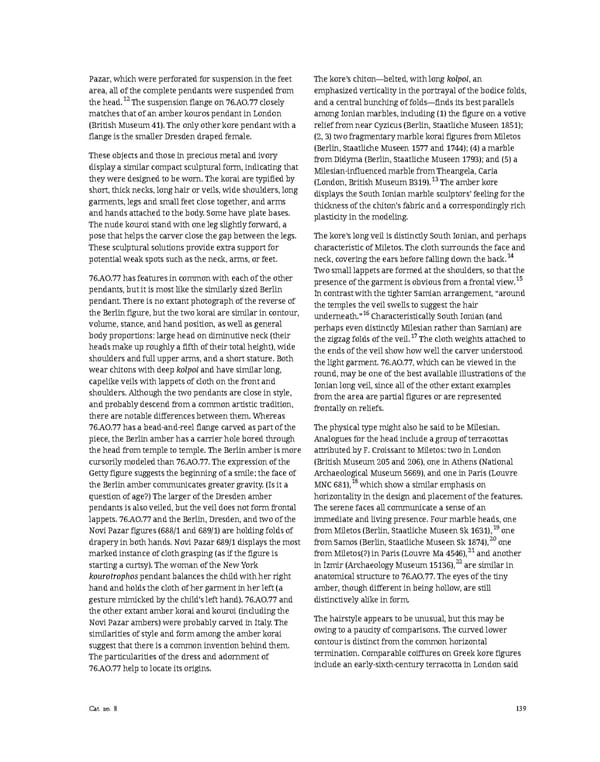Pazar, which were perforated for suspension in the feet The kore’s chiton—belted, with long kolpoi, an area, all of the complete pendants were suspended from emphasized verticality in the portrayal of the bodice folds, the head.12 The suspension flange on 76.AO.77 closely and a central bunching of folds—finds its best parallels matches that of an amber kouros pendant in London among Ionian marbles, including (1) the figure on a votive (British Museum 41). The only other kore pendant with a relief from near Cyzicus (Berlin, Staatliche Museen 1851); flange is the smaller Dresden draped female. (2, 3) two fragmentary marble korai figures from Miletos (Berlin, Staatliche Museen 1577 and 1744); (4) a marble These objects and those in precious metal and ivory from Didyma (Berlin, Staatliche Museen 1793); and (5) a display a similar compact sculptural form, indicating that Milesian-influenced marble from Theangela, Caria they were designed to be worn. The korai are typified by (London, British Museum B319).13 The amber kore short, thick necks, long hair or veils, wide shoulders, long displays the South Ionian marble sculptors’ feeling for the garments, legs and small feet close together, and arms thickness of the chiton’s fabric and a correspondingly rich and hands attached to the body. Some have plate bases. plasticity in the modeling. The nude kouroi stand with one leg slightly forward, a pose that helps the carver close the gap between the legs. The kore’s long veil is distinctly South Ionian, and perhaps These sculptural solutions provide extra support for characteristic of Miletos. The cloth surrounds the face and potential weak spots such as the neck, arms, or feet. neck, covering the ears before falling down the back.14 Two small lappets are formed at the shoulders, so that the 76.AO.77 has features in common with each of the other presence of the garment is obvious from a frontal view.15 pendants, but it is most like the similarly sized Berlin In contrast with the tighter Samian arrangement, “around pendant. There is no extant photograph of the reverse of the temples the veil swells to suggest the hair the Berlin figure, but the two korai are similar in contour, underneath.”16 Characteristically South Ionian (and volume, stance, and hand position, as well as general perhaps even distinctly Milesian rather than Samian) are body proportions: large head on diminutive neck (their the zigzag folds of the veil.17 The cloth weights attached to heads make up roughly a fifth of their total height), wide the ends of the veil show how well the carver understood shoulders and full upper arms, and a short stature. Both the light garment. 76.AO.77, which can be viewed in the wear chitons with deep kolpoi and have similar long, round, may be one of the best available illustrations of the capelike veils with lappets of cloth on the front and Ionian long veil, since all of the other extant examples shoulders. Although the two pendants are close in style, from the area are partial figures or are represented and probably descend from a common artistic tradition, frontally on reliefs. there are notable differences between them. Whereas 76.AO.77 has a bead-and-reel flange carved as part of the The physical type might also be said to be Milesian. piece, the Berlin amber has a carrier hole bored through Analogues for the head include a group of terracottas the head from temple to temple. The Berlin amber is more attributed by F. Croissant to Miletos: two in London cursorily modeled than 76.AO.77. The expression of the (British Museum 205 and 206), one in Athens (National Getty figure suggests the beginning of a smile; the face of Archaeological Museum 5669), and one in Paris (Louvre the Berlin amber communicates greater gravity. (Is it a MNC 681),18which show a similar emphasis on question of age?) The larger of the Dresden amber horizontality in the design and placement of the features. pendants is also veiled, but the veil does not form frontal The serene faces all communicate a sense of an lappets. 76.AO.77 and the Berlin, Dresden, and two of the immediate and living presence. Four marble heads, one Novi Pazar figures (688/1 and 689/1) are holding folds of from Miletos (Berlin, Staatliche Museen Sk 1631),19 one drapery in both hands. Novi Pazar 689/1 displays the most from Samos (Berlin, Staatliche Museen Sk 1874),20 one marked instance of cloth grasping (as if the figure is from Miletos(?) in Paris (Louvre Ma 4546),21 and another starting a curtsy). The woman of the New York in İzmir (Archaeology Museum 15136),22 are similar in kourotrophospendant balances the child with her right anatomical structure to 76.AO.77. The eyes of the tiny hand and holds the cloth of her garment in her left (a amber, though different in being hollow, are still gesture mimicked by the child’s left hand). 76.AO.77 and distinctively alike in form. the other extant amber korai and kouroi (including the Novi Pazar ambers) were probably carved in Italy. The The hairstyle appears to be unusual, but this may be similarities of style and form among the amber korai owing to a paucity of comparisons. The curved lower suggest that there is a common invention behind them. contour is distinct from the common horizontal The particularities of the dress and adornment of termination. Comparable coiffures on Greek kore figures 76.AO.77 help to locate its origins. include an early-sixth-century terracotta in London said Cat. no. 8 139
 Ancient Carved Ambers in the J. Paul Getty Museum Page 148 Page 150
Ancient Carved Ambers in the J. Paul Getty Museum Page 148 Page 150